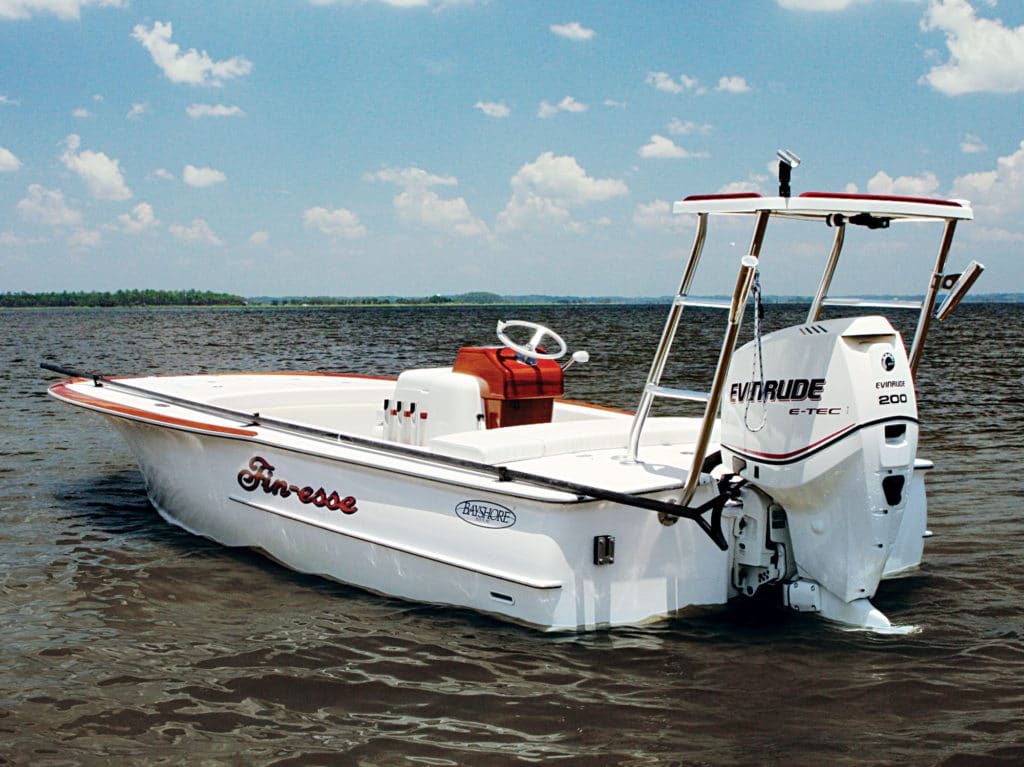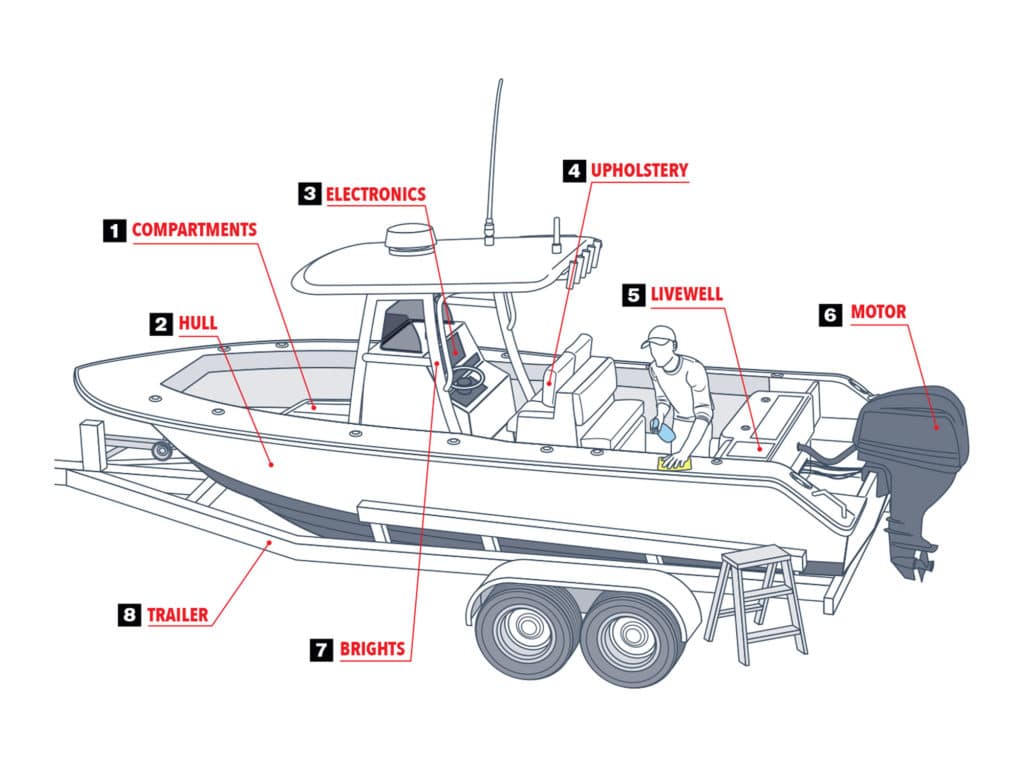
I just celebrated the second-best day in a boater’s life. After owning my Bayshore for a dozen years, I recently sold it to have a micro skiff built. A high-end, limited production flats boat, it took a few months to sell, but the deal came together quickly because it looked great and was ready to fish when the buyer came for a test ride. If you are ready to put your boat on the market, these tips expedite the sale and maximize the payoff. These companies offer checklist programs to accurately assess a boat’s worth:
Fix Your Boat Before Selling
“First impression and dock appeal is very important,” says Jim Greene, one of the original partners in the Marine Group in Orange Beach, Alabama, and a professional broker for 39 years. Greene specializes in custom-built boats and high-end production sport-fishing yachts, and also owns a marine service business. “Once they step aboard, guys go straight to the engine room and women go inside. If the engine room is a ball of rust with sparks flying or the inside smells like septic hoses, they’re turned off immediately. If it’s clean, bright, and smells and looks good, then you’ve got a good chance to make the sale.”
Greene adds that sellers who detail their boats and ensure everything is working properly won’t necessarily get more money, but it does help boats sell faster. Logically, you don’t want to reduce the profit margin with needless spending. There are reasonable ways to make the boat more marketable, however, starting with that all-important appearance.
TIME-HONORED PRICING GUIDE nadaguides.com (cars, trucks, trailers, RVs, boats and more)
MOST POPULAR BOAT SPECIFIC boattrader.com (selling advice and value guidelines)
WIDE RANGE OF RESOURCES boatus.com (estimates offered to members only)
Advertisement
Clean Your Boat
A dirty boat is a sign of neglect, yet that’s easily remedied with time and elbow grease. Remove mold and mildew from compartments, bilges and upholstery with a diluted bleach solution. Stubborn hull stains, water spots and scum lines may require compounding and buffing. Next, apply a coat of marine wax and buff to a shine. A mild abrasive powder helps to scour nonskid decks. Scrub fabrics, like T-top covers, with a mild detergent and then rinse. Use a polishing compound on aluminum and stainless hardware. Make the boat look as good as it possibly can, even if that entails minor fiberglass repairs to spider or stress cracks.
Engines require attention too. Start by cleaning any rust or corrosion under the cowling and the exterior sections, then apply a corrosion preventive. Grease the fittings and replace worn parts, like cracked hoses and filters. Wipe away any excess grease or soot. Clean the cowling and give it a coat of wax as well. Use touch-up paint to refresh the outboard skeg, then buff and file the propeller blades, if necessary. Have your service center compile records or run a diagnostic test on the engine history that you can show to potential buyers.

- COMPARTMENTS: Clean mold and stains, check latches and hinges
- HULL: Clean water marks or stains, fix cracks, wax
- ELECTRONICS: Run all functions, check wiring, clean displays
- UPHOLSTERY: Clean and treat with vinyl restorer
- LIVEWELL: Check pumps, remove stains
- MOTOR: Remove rust, lube where needed, check wiring and hoses, change oil and filters
- BRIGHTS: Polish all stainless and aluminum
- TRAILER: Check all hardware, lights and bearings
Make Your Boat Fishing Ready
Electronics and accessories add appreciable value to a boat and set it apart from comparable models. Make sure everything is working properly. Check electrical connections for corrosion, intact terminal lugs, and working circuit breakers and fuses. Clean component displays, and wipe down the housings with Armor All or a similar solution to restore luster. Power up and check fish finders, plotters, radar, radios, antennas and sound systems for proper operation. Don’t forget to wire brush any residue from the battery terminals, top off fluids and tighten fasteners.
Focus on other operational systems next. Check the bilge and livewell pumps to ensure they are working when needed. Trim tabs, the jack plate, anchoring systems and windlasses are next on the list. If you find rust or corrosion, treat it. Outriggers, electric downriggers and 12-volt outlets also need operational checks and cleaning. Do the same for navigation, spreader and courtesy lights. Go over the boat completely and inspect the upholstery and cushions for tears, ripped-out snaps or frozen zippers; fix or replace damaged items.
Finally, check all the hardware for corrosion and integrity. If you use a trailer, don’t neglect it either. Check tire pressure and wear, including the spare. Inspect the fasteners, bunk carpeting, rollers, winch, coupler and axles. Make sure the wheels spin freely and repack the bearings if needed. Plug the lights in to make sure they illuminate properly.
This may seem like a lot of work, and it is. But much of it can be done with cleaning gear and a few common tools or by a service facility. Either way, it will be a worthwhile investment when the buyer sees your showroom-ready ride and hands over a check for your full asking price.
Boat Seller’s Checklist
Clean and detail the boat thoroughly.
Take plenty of photographs of the interior, standard/optional features, accessories, engines, and the hull and exterior, both in and out of the water.
Research comparable boat listings to determine an accurate market value.
A detailed listing description will help spur interest and eliminate unnecessary questions.
Professional brokers charge a standard 10 percent to list and market the boat.
If listed on a forum or community website, bump the listing to the top as often as allowed.
Be aware of Internet scams or phishing attempts.
Conduct the transaction in a public place. Confirm available funds from the issuing financial institution before the title is transferred. If paid in cash, check multiple identifiers on bills to ensure they are not counterfeit. Both parties should date and sign the bill of sale, and specify any conditional provisions in writing.
Hand over service records, warranty information and the title/registration to the buyer.
Cancel the insurance within 24 hours of the sale.









